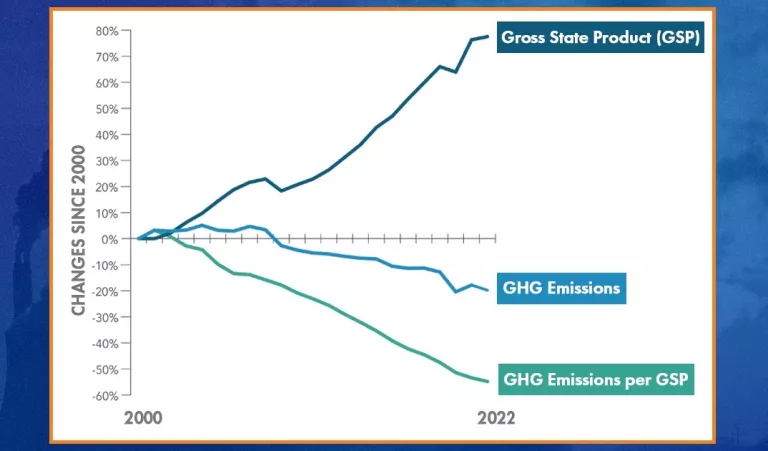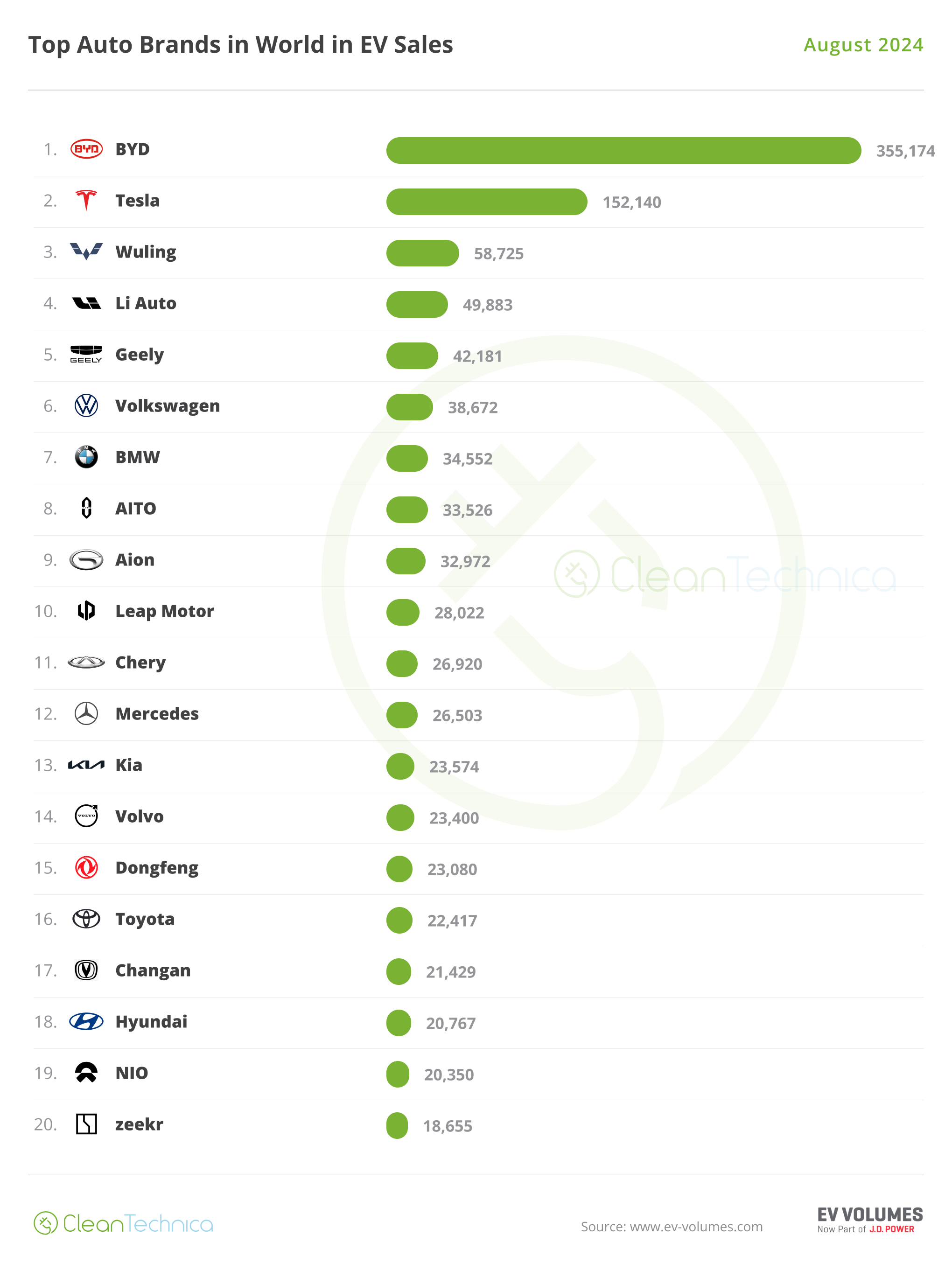Sign up for daily news updates from CleanTechnica on email. Or follow us on Google News!
California is making strides in reducing emissions while the economy continues to grow. Check out some of the state’s recent wins!
California continues to charge forward with significant climate wins:
- The California Air Resources Board (CARB) just released a report showing that California’s emissions continue to fall — a 20% reduction since 2000 — at the same time that the state’s economy has grown substantially.
- A $10 billion climate bond will go to voters (Prop 4) in November to support adaptation, water security, sustainable agriculture and clean energy — and is polling well!
- In a major win for environmental justice communities, NRDC, and our allies and supporters, Big Oil was forced to pull its referendum to undermine the oil well setbacks protections. All new wells and redrilling of existing wells must be a minimum of 3,200 feet away from homes, schools, and daycare centers.
- We also made substantial progress in key sectors — buildings, industry, transportation, power — highlighted below.

Buildings
Building code delivers: The California Energy Commission (CEC) approved a new building energy code that ensures the vast majority of new homes in the Golden State will be built without fossil fuel connections by 2026. Additionally, spurred by NRDC analysis on the opportunity to replace burnt out AC units with heat pumps that can cool and heat, the new code includes provisions to strongly encourage the replacement of gas rooftop HVAC (heating ventilation air conditioning) units for existing commercial buildings with two-way heat pumps. These units account for roughly 25% of the commercial market in California. A heat pump is nearly identical to an air conditioner with one small but important difference: a reversing valve that allows it to provide heating or cooling. This no brainer is becoming the norm for commercial buildings and needs to be the standard for residential homes too.
Stop investing in fossil fuel infrastructure: There is a growing consensus that it doesn’t make sense to keep investing in the gas pipeline system in California. NRDC commissioned analysis showing that targeted electrification, which equips homes served by aging gas pipelines with energy-efficient electric appliances, can save utility customers more than $20 billion in gas infrastructure costs by avoiding costly pipeline replacements.
Last week, Governor Newsom signed SB 1221 (Min) into law, a bill sponsored by NRDC, Earthjustice, and Building Decarbonization Coalition designed to avoid pipeline replacements. SB 1221 will help ensure that utility spending is aligned with an affordable, clean energy future by increasing transparency into gas utilities’ planned fossil fuel investments and authorizing cost-saving “zero-emission alternative” pilot projects to take place across the state. With this bill, California joined a growing list of states that are closing the chapter on unnecessary gas pipeline investment.
In July, the California Public Utilities Commission (CPUC) also implemented a decision that removes the subsidies for electric line extensions in new buildings if they connect the building to the gas system — subsidies worth thousands of dollars per home to developers. The decision recognizes that subsidies for new buildings that burn gas are out of step with California’s climate and public health objectives and builds on the previous move to eliminate the gas line extension subsidies for new properties.
Ensuring clean, electric technology is available to all: Getting off fossil gas in buildings requires investing in clean, electric technologies and supporting households with fewer resources to make the transition. California continues to fund this work above and beyond the federal dollars for buildings flowing to the state:
- A total of $525 million was secured for the Equitable Building Decarbonization program, which will provide home repairs and install all-electric appliances in the residences of low-income Californians starting in 2025.
- The $71 million from the Aliso Canyon Settlement paid by SoCalGas was directed primarily to support building electrification in the Los Angeles region (appropriated through AB 157).
- The California Heat Pump Partnership (CAHPP), seeded with state funding, officially launched this year to bring together state agencies, utilities, and manufacturers representing more than 90% of the U.S. heat pump market to help achieve the state’s goal to install six million electric heat pumps by 2030.
Industry
Digging into industrial emissions: Recently signed by the Governor, SB 941 (Skinner) requires CARB to assess emitting industrial technologies and the availability of zero-emission alternatives in its next scoping plan. This assessment is a good first step to take stock of industry’s decarbonization options and should be followed by a comprehensive plan to abate those emissions.
Federal funding for cement decarbonization: Two innovative California-based cement companies secured federal funding awards of nearly $700 million to demonstrate decarbonized cement production processes. Successful adoption of such technologies will be crucial to meeting SB 596, which requires all cement used in the state to be net-zero emission by 2045.
Exploring new rates for industrial electrification: Electric rates that incentivize industrial loads to use clean electricity are critical to industrial decarbonization. While SB 993 (Becker), which would have required just such an industrial rate development, did not advance out of the legislature, the idea did: the CPUC updated the scope of its existing demand flexibility proceeding to develop a new industrial electric rate structure for industrial heat and hydrogen loads. This could price electricity at super low rates when renewables are abundant, and much higher when gas is the marginal resource to incentivize flexible industrial loads to only draw power from the grid when the costs and emissions of doing so are low.
Transportation
Transforming our streets and highways: Two of the three bills NRDC supported as part of the ClimatePlan legislative package were signed into law. SB 960 (Wiener) requires Caltrans to make improvements for people biking, walking, and taking transit when it upgrades state-owned roads. AB 2086 (Schiavo) requires tracking and reporting on how state transportation investments support state goals on safety, equity, climate action, and economic prosperity. Each of these bills advances a key recommendation from our report highlighting gaps between California’s climate goals and its transportation infrastructure spending decisions. NRDC also filed a lawsuit against Caltrans for its unlawful approval of an expansion of Interstate 80 in the Sacramento region.
Defend clean cars rules: NRDC and partners helped block four bills that would have weakened California’s nation-leading clean air standards. We successfully secured the Governor’s vetoes of AB 637 (Jackson), AB 3179 (J. Carillo), Ab 1122 (Bains) and AB 1296 (Grayson), which would have given clean air carveouts for certain rental cars, vehicle fleets, and harbor craft.
Getting EV chargers online faster: NRDC worked to secure new rules from the CPUC to get EV chargers online faster to meet the growing demand for electric cars, buses, and trucks. This decision establishes the nation’s first deadlines for connecting residential, public, and workplace EV chargers to the grid and for California’s three largest investor-owned utilities to make necessary grid upgrades to support large projects like fast-charging plazas for passenger vehicles and charging stations for commercial trucks, while also requiring transparent data on utility compliance. The rule will help lower electricity rates because EV charging brings in more money than it costs utilities to serve, and that net revenue is returned to all utility customers through rates and bills that are lower than they otherwise would be.
Power
Offshore wind gets green light: Developing offshore wind (OSW) is important for California to meet its zero-carbon energy goals, support grid reliability, improve affordability, reduce air pollution, and grow a new industry that will support thousands of high-quality jobs. To advance this effort, the CEC published their final strategic plan, with feedback from NRDC and other stakeholders, which outlines opportunities, challenges, and recommendations to make responsible and equitable offshore wind development a California reality.
In a huge step towards this potential, the CPUC sent the strongest signal yet to advance OSW by adopting a decision ordering 7.6 GW of OSW to be centrally procured by 2035. This determination of need is significant enough to provide certainty for transmission, port, and other infrastructure investments to move forward, and is in line with what NRDC supported in our comments. This decision affirms that offshore wind will play a key role in California’s future energy system and lays the groundwork for market transformation by planning phased procurements to encourage competition and cost reductions.
Progress on Western grid regionalization: A west-wide electricity market would spur the development of clean electricity sources and lower costs for consumers across the region. With the California Independent System Operator’s (CAISO) western day-ahead electricity market approved by the Federal Energy Regulatory Commission (FERC) and poised to bring some of these benefits to the region, an additional effort is underway called the West-Wide Governance Pathways Initiative to take it even further. The Pathways Initiative will both encourage broad participation in the western day-ahead electricity market to capture the value of the resource and geographic diversity of the region, and will create a path to stand up a new governance structure with full independence that could offer more services to the West that go beyond energy markets.
Equitable rate reform to improve how we pay for shared electric system costs: California is facing an electric rate crisis. NRDC has been at the forefront of identifying solutions, including an income-based monthly charge that more equitably shares the costs for electricity infrastructure while also supporting the transition from fossil fuels to clean electricity. The CPUC successfully adopted this new rate structure in May. This change will help, but more needs to be done in 2025 to reduce electric rates.
Looking Ahead
There’s still significant work needed to build a just and sustainable California, however, the recent progress made across every major sector is worth celebrating. California has the vision and leadership needed, and the will of the state’s residents on its side to create a livable future for all in the face of climate change.
By Merrian Borgeson & Yahya Yaziji. Courtesy of NRDC.

Have a tip for CleanTechnica? Want to advertise? Want to suggest a guest for our CleanTech Talk podcast? Contact us here.
Latest CleanTechnica.TV Videos
CleanTechnica uses affiliate links. See our policy here.
CleanTechnica’s Comment Policy




